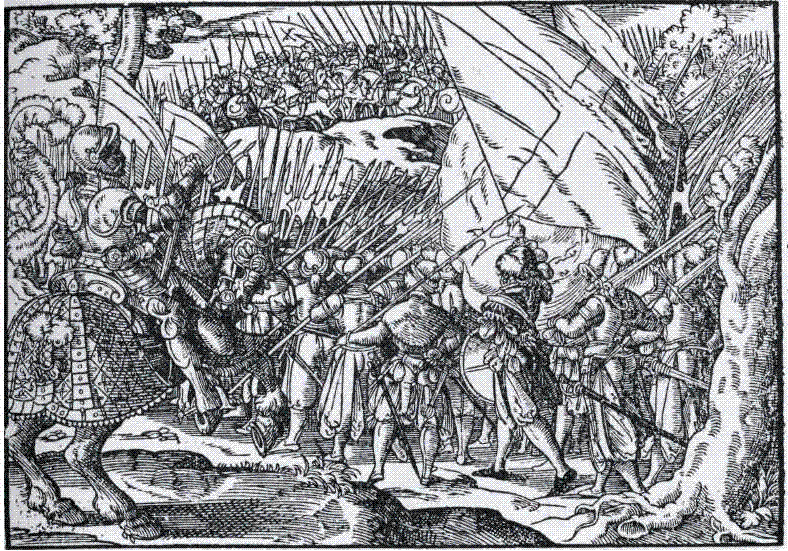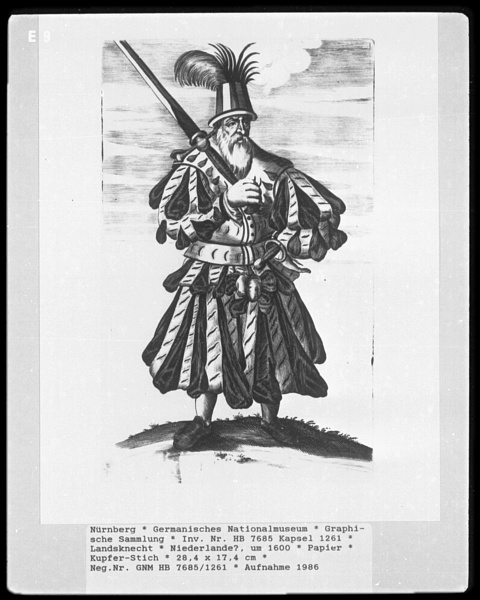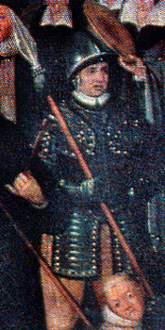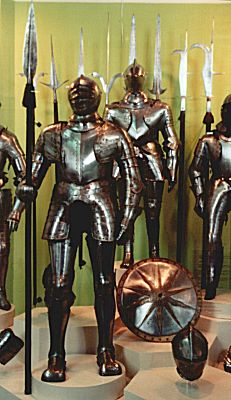| Author |
Message |
|
Joe Mejia
Location: Chicago, IL, USA Joined: 17 Mar 2008
Posts: 13
|
 Posted: Fri 28 Jan, 2011 11:47 am Post subject: Great Swords circa 1600 Posted: Fri 28 Jan, 2011 11:47 am Post subject: Great Swords circa 1600 |
 |
|
A few friends and I are forming some impressions of western style mercenaries aiming to portray roughly the times 1590-1620, revolving around the "Time of Troubles" and the conflicts between Poland and Russia. One of our guys owns a Cold Steel Two Handed Great Sword and, despite our protestations, insists that they were used during the period though he has trouble presenting any documentation. He claims they were being taught in "Italian fighting academies", but wants to carry it around as we depict soldiers on a campaign.
Can anyone here help either prove or disprove him? He claims fighting treatises mean they were still common weapons. We claim they appear virtually no where in the art of the period or any historical documents we've come across.
What are your opinions?
|
|
  |
 |
|
Tjarand Matre
Location: Nøtterøy, Norway Joined: 19 Sep 2010
Posts: 159
|
 Posted: Fri 28 Jan, 2011 12:05 pm Post subject: Posted: Fri 28 Jan, 2011 12:05 pm Post subject: |
 |
|
Wikipedia says the following: "A fanciful depiction of a Zweihänder used against a halberd in a battle line appears in a Polish chronicle dated to 1597." Being Wikipedia and not quoting what chronicle I'd try to verify that with at least one other source.
ARMA has an article on 2-handers here: http://www.thearma.org/essays/2HGS.html with references to these swords being made well in to 17th century. I know there are quite a few Swedish 2-handers made in very late 16th and early 17th century on display in Livrustkammaren in Stockholm. Sweden was also at war with Poland on several occations from 1600 and onwards so he could always claim a Scandinavian link ;-)
I doubt however that they were very common which is probably why your 2-hander guy is having a hard time to find sources.
|
|
   |
 |
Morgan Butler

|
 Posted: Fri 28 Jan, 2011 12:16 pm Post subject: Posted: Fri 28 Jan, 2011 12:16 pm Post subject: |
 |
|
I believe the 2-hander was taught as a style of Fencing probably up to the early,early 1600's. It is after all weapon that is used without a shield, so it is relied upon for both offense and defence, erogo= Fencing. I agree however that It was very rare in the 17th century.
inkothemgard!
|
|
  |
 |
Mackenzie Cosens

Location: Vancouver Canada Joined: 08 Aug 2007
Posts: 238
|
 Posted: Fri 28 Jan, 2011 3:39 pm Post subject: Posted: Fri 28 Jan, 2011 3:39 pm Post subject: |
 |
|
Thibault d' Anvers, Academy of the Sword, 1630 ISBN:1-891448-40-4 has 3 chapters (40,41,42) on defending yourself against someone armed with a two-handed sword. The chapters may exist just for completeness or perhaps in was to deal with a real threat. Personally, because they come before the chapters on facing a left-handed swordsman and facing a Musketeer both real threats in the early 17th century, I think the two-handed sword may well be a real threat.
A counter argument to it being a real threat is that that style of two-handed sword is similar to practice weapons shown in late 16th century German fight books (example Meyer) and exist to counter the argument, "I go get a two-handed sword and beat you through your flimsy little rapier like a harp seal"
|
|
  |
 |
Greg Coffman

|
 Posted: Fri 28 Jan, 2011 4:25 pm Post subject: Posted: Fri 28 Jan, 2011 4:25 pm Post subject: |
 |
|
Thibault's two hander is pretty much the same as Meyer's longsword. Thibault taught a Spanish manner of fencing and the Spanish "two hander," the Montante, was pretty much representative of those longswords on the large side, including great swords. These are all different, and generally smaller, than the true "two handed sword," (zweihander), which were known in-period as biddenhander (both-hands) or doppelhander (double-hands). The Cold Steel sword definitely belongs to this second category of swords.
There was certainly use of some form of two handed sword, either zweihander or montante configuration, at least until 1651 when both Diogo Gomes de Figueyredo and Francesco Alfieri, included teachings on it. Figueyredo is using the montante and Alfieri's sword features a simple cross without parrying hooks (http://www.thearma.org/Manuals/NewManuals/Alfieri/05003197.jpg). But we don't know how much service these sword saw on the battlefield. Even in the 16th century, they were relegated to guarding the banner or officers, carried by a small percentage of the elite soldiers (who themselves made up only a fourth of any formation) or carried by officers themselves as somewhat of a badge of office.
 Attachment: 162.08 KB Attachment: 162.08 KB

Here is the latest image I have that depicts soldiers carrying dopplehanders. Notice they follow the banner and are probably banner guards.
 Attachment: 92.1 KB Attachment: 92.1 KB

Here is a late landsknecht with a two-hander of the smaller configuration.
 Attachment: 57.54 KB Attachment: 57.54 KB
And here is a photo showing a variety of two-handers. From Invalides, Paris [ Download ]
For the word of God is living and active. Sharper than any double-edged sword, it penetrates even to dividing soul and spirit, joints and marrow; it judges the thoughts and attitudes of the heart.
-Hebrews 4:12
|
|
  |
 |
|
Joe Mejia
Location: Chicago, IL, USA Joined: 17 Mar 2008
Posts: 13
|
 Posted: Fri 28 Jan, 2011 5:22 pm Post subject: Posted: Fri 28 Jan, 2011 5:22 pm Post subject: |
 |
|
Thank you for the good information so far. I am liking having some actual sources rather than just the hearsay he has presented.
Greg, what is the source of the woodcut with the guys guarding the banners?
Regarding using them as an officer's status symbol: would it then be carried with them into battle, or something they just took up when having a painting done (as in 18th century breastplates)? The Polish nobility often carried maces, bulawas, that would sometimes be highly adorned, but these were not intended as weapons, merely as symbols of power.
Our guy wants to portray an officer (someday), so maybe this would work for him. But I want all our facts to be straight as to whether it was a combat weapon or whether this is just something he carries and that his persona may have learned "at school".
|
|
  |
 |
Greg Coffman

|
 Posted: Fri 28 Jan, 2011 7:14 pm Post subject: Posted: Fri 28 Jan, 2011 7:14 pm Post subject: |
 |
|
I don't have a source for the woodcut. I scavenge pics from the internet and don't often find citations.
I think it would be carried into battle. There are battle depictions of doppelhanders in use so it was definitely used.
For the word of God is living and active. Sharper than any double-edged sword, it penetrates even to dividing soul and spirit, joints and marrow; it judges the thoughts and attitudes of the heart.
-Hebrews 4:12
|
|
  |
 |
|
Joe Mejia
Location: Chicago, IL, USA Joined: 17 Mar 2008
Posts: 13
|
 Posted: Sun 30 Jan, 2011 9:04 pm Post subject: Posted: Sun 30 Jan, 2011 9:04 pm Post subject: |
 |
|
|
But as for officers? Would they really carry a weapon like that into battle, intent on breaking up pike blocks? I thought the reason the zweihander guys were paid so much was that they weren't expected to live very long. Would an officer with presumably more at stake seriously take on that role?
|
|
  |
 |
|
Sam Gordon Campbell
Location: Australia. Joined: 16 Nov 2008
Posts: 678
|
 Posted: Sun 30 Jan, 2011 10:00 pm Post subject: Posted: Sun 30 Jan, 2011 10:00 pm Post subject: |
 |
|
I think it would be better to err on the side of caution (and of course avoid the "absence of evidence is not evidence of absence" argument), so if he want to carry a bein/dopple/zweihander, then he could escort whoever bares the banner. I just hope he knows how to actualy use it.
And with regards to officers carrying them, I'd assume that an officer is not going to be the 'first into the fray' sort of position, so baring such a large sword may serve as a practical symbol of rank and, if needs be, boost morale by using it for a time.
Member of Australia's Stoccata School of Defence since 2008.
Host of Crash Course HEMA.
Founder of The Van Dieman's Land Stage Gladiators.
|
|
  |
 |
Sean Flynt

|
 Posted: Mon 31 Jan, 2011 7:14 am Post subject: Posted: Mon 31 Jan, 2011 7:14 am Post subject: |
 |
|
I doubt that an officer would carry such a weapon with an expectation of use. The thinking in the 18th c. was that officers should not carry muskets because they must not be distracted from their field duties. The point is that you can't manage your troops if you're fighting, and that theory would apply to earlier periods as well. Polearms were considered an appropriate weapon for foot officers because they're easily identified on the field, at least as useful as the bayonet and require no attention during the fight. By 1600, the halberd was on its way to becoming such a badge of rank. Ditto for partisans and boar spears. In fact, the boar spear appears to have become a symbol of rank by the first decade of the 16th c. That was still the case in the later part of the century. I would suggest that your friend get the Windlass European spear head for about $45 and mount it on a plain 6' poplar dowel. That's suitable for a mercenary with aspirations to leadership. Add a tassle and make it a non-com's weapon of office. Add velvet and tacks and make it a bodygaurd's or field officer's weapon.
 Attachment: 110.59 KB Attachment: 110.59 KB

 Attachment: 28 KB Attachment: 28 KB

-Sean
Author of the Little Hammer novel
https://www.amazon.com/Little-Hammer-Sean-Flynt/dp/B08XN7HZ82/ref=sr_1_1?dchild=1&keywords=little+hammer+book&qid=1627482034&sr=8-1
|
|
   |
 |
|
Nicholas A. Gaese
Location: Montreal, Quebec, Canada Joined: 06 Aug 2007
Posts: 100
|
 Posted: Mon 31 Jan, 2011 8:43 am Post subject: Posted: Mon 31 Jan, 2011 8:43 am Post subject: |
 |
|
Exactly as Sean said, even in the early 16th c. the captain and his lutenants in landsknecht companies often used boar spears and sometimes halberds, normaly something that other soldiers werent using so as to be easily identified.
Now I wont say it was impossible or was never done, but again as was already stated officers are sopposed to lead and direct troops, not run into the fray. If your friend wants to use a two hander and stay true to the norm, then he would normaly be the one guarding the officers so that they could do their job when things get hairy.
p.s. as a side note, two handers as everyone may know primarily served to guard the standard but the captain may also had some as personal bodyguards, depending on the time frame and the number of swordsman employed. officers such as lutenants or feldweybels as seen in German companies would not have bodyguards.
|
|
  |
 |
Greg Coffman

|
 Posted: Mon 31 Jan, 2011 5:33 pm Post subject: Posted: Mon 31 Jan, 2011 5:33 pm Post subject: |
 |
|
| Joe Mejia wrote: | | But as for officers? Would they really carry a weapon like that into battle, intent on breaking up pike blocks? I thought the reason the zweihander guys were paid so much was that they weren't expected to live very long. Would an officer with presumably more at stake seriously take on that role? |
The doppelhanders weren't necessarily there to break up opposing pike blocks. Nor did the doppelsoldners have a shorter life expectancy than the other troops. The doppelsoldners received double pay because they were either experienced soldiers or they had better equipment, i.e. armor. Often it was both. The presence of doppelsoldners stiffened up the rest of the ranks.
| Nicholas A. Gaese wrote: | | Exactly as Sean said, even in the early 16th c. the captain and his lutenants in landsknecht companies often used boar spears and sometimes halberds, normaly something that other soldiers werent using so as to be easily identified. |
In the early 16th century, other soldiers certainly were using halberds. The Swiss relied heavily on their halberds, and the majority of landsknecht doppelsoldners would be carrying halberds instead of doppelhanders or arquebuses.
Staying out of the fray to lead and direct troops might be great for a colonel or maybe even a captain or lieutenant. But many of the NCO's such as on the sergeant would certainly be standing in the pike formation and be expected to shoulder their fair share of the combat. Throughout the 16th century, classical Roman sources were informing much of the contemporary military thought. Roman sources put a high premium on officers leading troops by example of their own courage and feats in combat. King James IV of Scotland got himself killed at Flodden Field because he chose to lead from the front.
But even the captains of landsknecht companies served on foot. And while the weapons of the various officers and NCO's certainly also had to do with rank, I bet the weapons were always sharp...
And I think the structure and culture of officer corps of the 17th and 18th centuries were very different from that of the 16th when "officer corps" had not really become established. Unless I'm mistaken, the captains of today still carry rifles. While they may not be in a place to do most or any of shooting, they certainly are prepared to if need be. I'd guess that matches up with the 16th century.
For the word of God is living and active. Sharper than any double-edged sword, it penetrates even to dividing soul and spirit, joints and marrow; it judges the thoughts and attitudes of the heart.
-Hebrews 4:12
|
|
  |
 |
|
Nicholas A. Gaese
Location: Montreal, Quebec, Canada Joined: 06 Aug 2007
Posts: 100
|
 Posted: Mon 31 Jan, 2011 6:08 pm Post subject: Posted: Mon 31 Jan, 2011 6:08 pm Post subject: |
 |
|
to Greg
You are certainly right, the halberd was a very popular weapon in both German and Swiss companies, often with whole ranks armed as such. What I particularly meant was that officers in particular sometimes used halberds. If im not mistaken the German version of NCO's at the time were called "feldwybel" and most certainly marched with their detachment into battle, and they however are often depicted armed with halberds or partizan-like weapons.
Just to add, it has been documented that the majority of doppelsoldners were actually armoured pikemen, thus me in my mind defining a Doppelsoldner as an armoured soldier who is either experianced or has recieved a higher level of training, rather then only as a double payed shock trooper. Don't want to derail the topic though so for further reading please take a look at this thread:
http://www.myArmoury.com/talk/viewtopic.php?t=16442
Edit: just to add once again that while going through the thread, pay close attention to the posts of forimite Daniel staberg, as he posted whole armaments and soldier rankings of entire Landsknecht faehnleins throughout the 16th century,
regards
Nick
|
|
  |
 |
|
|
You cannot post new topics in this forum
You cannot reply to topics in this forum
You cannot edit your posts in this forum
You cannot delete your posts in this forum
You cannot vote in polls in this forum
You cannot attach files in this forum
You can download files in this forum
|
All contents © Copyright 2003-2025 myArmoury.com — All rights reserved
Discussion forums powered by phpBB © The phpBB Group
Switch to the Basic Low-bandwidth Version of the forum
|

